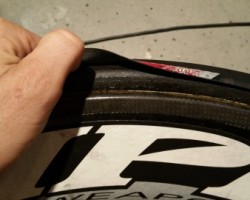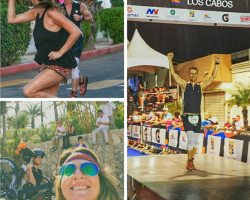It’s been a week since I competed in Ironman Cabo and my body and mind are finally feeling back to normal. The Ironman is aptly named as it’s a 2.4 mile swim followed by a 112 mile bike and then a 26.2 mile run. It takes the best competitors in the world about 9 hours to complete while most people finish in 12-15 hours. It took me 16 hours thanks to my lack of endurance athleticism, a set of unfortunate race occurrences and what has to be one of the hardest IRONMAN courses in history. This was no normal race. Out of the 908 entrants just 625 finished. That’s a DNF rate of 30%. To put that in perspective the average DNF rate is about 5-10% at an Ironman event. So, while I’m not particularly proud of my time I am glad I survived! That said, good Ironman competitors (not me) are a different type of human being. My respect for them has gone through the roof after trying such an event.
An Ironman is the sort of event that is literally life changing. The amount of preparation and then the mental and physical agony you go through during the day will change your perspective on so many things. Here are some of the big lessons I learned during my preparation and during the race:
- Do Your Research Before Committing to Something. I picked the Cabo Ironman because I wanted to do an international event that wouldn’t be too difficult. Living in San Diego, Cabo is a pretty easy flight and since the race had been moved to October I figured the weather might be a bit nicer than the previous years in March when it’s windy. But I made a colossal research mistake. The 2014 Cabo Ironman was a flat race because there were numerous complaints in the race’s inaugural year (2013) when there was a huge mountain section that coincided with high wind conditions. The 2013 DNF rate was 33% which is very high. So they changed the course in 2014 to make it much flatter. Then in 2015 they decided to change the time of year of the race to make it more accommodating for the weather. BUT, they added the mountain section back in. To make matters worse, they appear to have miscalculated the elevation gain during the bike section (the race guide said 3,800 feet while most people’s Garmin’s picked up 6,100 feet). Turns out they used last year’s course profile which means that people trained for a relatively flat course that ended up feeling like one quarter of Mount Everest. I didn’t do my research, prepared for an average amount of bike climbing and paid the price.
- Predicting the Future is Really Difficult. I decided this race would be a nice one because the average temperature in Cabo in late October is 79 degrees and the water tends to be cool. This was important because the swim section is usually easy for me in large part because you can wear a wetsuit which adds buoyancy. But this year has turned out to be an El Nino year and the water in Cabo was in the high 80s while the air temperature averaged 85 degrees during race day. As a result they prohibited wetsuits which meant we did the ocean swim without wetsuits and then biked in blistering 90+ degree weather. I made a very bad prediction about the weather and paid the price on the bike.
- You Don’t Always get What You Pay For. I purchased fancy “race wheels” and had expensive tires installed on them. These tubular tires are supposed to be faster and more reliable than traditional clincher tires. Around mile 40 of the bike I started hearing a clicking sound, but I couldn’t diagnose it. I figured my brakes were slightly rubbing and kept trucking. Around mile 70 I noticed a guy in front of my who had massive sweat marks on his backside. I had a ton of extra salt tabs so I pulled up next to him and told him to take the bag. He was very grateful (he later passed me on the run, ha). About 20 miles later someone else pulled up behind me and said “hey dude, your back tread is coming totally loose! I would be careful on that tire”. My
 good karma had come back around. I got off my bike and noticed that the tread on my rear tire was coming completely loose and that the tire was half filled. Because I was at mile 90 and not thinking clearly I decided to keep going, but I took all the downhills very slow. That guy might have saved my life. Who knows what could have happened if the tread had come completely off while I was storming downhill at 30 MPH. But more importantly, I learned that you don’t always get what you pay for. My fancy tires totally failed me during the bike.
good karma had come back around. I got off my bike and noticed that the tread on my rear tire was coming completely loose and that the tire was half filled. Because I was at mile 90 and not thinking clearly I decided to keep going, but I took all the downhills very slow. That guy might have saved my life. Who knows what could have happened if the tread had come completely off while I was storming downhill at 30 MPH. But more importantly, I learned that you don’t always get what you pay for. My fancy tires totally failed me during the bike. - Have a Good Plan (not necessarily the best plan) and Stick With it. The most important part of a big endurance event like this is the preparation and then the plan during the event. You have to put in hundreds or even thousands of hours of training to be properly prepared for such an event. My goal was modest (13-14 hours) and I constructed a plan that would get me there (email me if you want it). It wasn’t the best plan in the world, but it was an adequate plan. And for an entire year I stuck to that plan. Every. Single. Day. Then on race day I had a specific fueling plan. I knew I’d be burning 400-500 calories an hour and that I needed to be consuming about 300-400 calories per hour because my body can’t digest more than that per hour. So I constructed a very specific plan to eat and drink the appropriate amount and right type of calories every 20 minutes. You are literally eating and drinking during the entire event like an Ironman. And the fueling plan is almost more important than being in good shape. But the thing is, when you’re an amateur like me who is just trying to finish, you don’t need the best plan. You just need a good plan and to stick with it.
- You’re Only as Strong as The People You Surround Yourself with. An Ironman event appears like the ultimate individual event. But that’s so far from the truth. When you train for an event like this you have to make huge sacrifices that require a lot of support from friends and family. And then during the event you rely entirely on the volunteers who hand out water, gatorade, food, etc. And then when you’re in your darkest moments (and there are lots of them during a day like that) you reach into the inner strength provided by all the people who you know are supporting you. My wife had handed me an envelope minutes before the race started and I stuck it in my pocket thinking I’d look at it at my weakest point. That moment occurred for me at about mile 80 on the bike when I seriously considered quitting, read the note and looked at the attached pictures and realized that there was no way I could quit.
- There Are More Important Things in Life Than Big Personal Goals. An Ironman is something that I never thought I could do especially considering I could barely run a 5K three years ago. But it turned into a big life goal of mine that came with a hefty price tag. Honestly, I will probably never do something like this again in my life and I am not certain that it paid off. For me
 personally it took a big toll on my personal life and my professional life. The time commitment was just too much for me to handle at this point in my life when I have a young family and a young business. And I realized after it was all over that I had neglected so many people I love just because I was so focused on this one personal life goal. I had let a big personal goal of mine consume so many other important things in my life. While I am proud of the personal achievement it didn’t really fit my broader goals of trying to maintain a really balanced life.
personally it took a big toll on my personal life and my professional life. The time commitment was just too much for me to handle at this point in my life when I have a young family and a young business. And I realized after it was all over that I had neglected so many people I love just because I was so focused on this one personal life goal. I had let a big personal goal of mine consume so many other important things in my life. While I am proud of the personal achievement it didn’t really fit my broader goals of trying to maintain a really balanced life.
I hope my lessons provide some clarity and lessons for everyone reading. And to those who supported me during the race – you have no idea how thankful I am.
Mr. Roche is the Founder and Chief Investment Officer of Discipline Funds.Discipline Funds is a low fee financial advisory firm with a focus on helping people be more disciplined with their finances.
He is also the author of Pragmatic Capitalism: What Every Investor Needs to Understand About Money and Finance, Understanding the Modern Monetary System and Understanding Modern Portfolio Construction.

